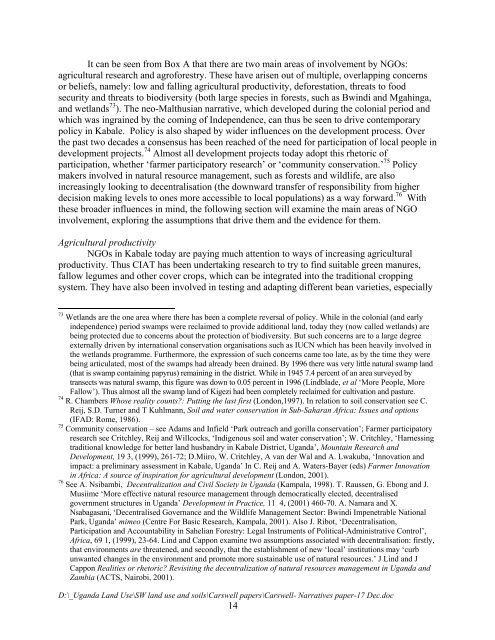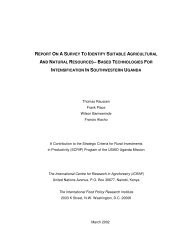Continuities in environmental narratives, Kabale, Uganda ... - Foodnet
Continuities in environmental narratives, Kabale, Uganda ... - Foodnet
Continuities in environmental narratives, Kabale, Uganda ... - Foodnet
Create successful ePaper yourself
Turn your PDF publications into a flip-book with our unique Google optimized e-Paper software.
It can be seen from Box A that there are two ma<strong>in</strong> areas of <strong>in</strong>volvement by NGOs:<br />
agricultural research and agroforestry. These have arisen out of multiple, overlapp<strong>in</strong>g concerns<br />
or beliefs, namely: low and fall<strong>in</strong>g agricultural productivity, deforestation, threats to food<br />
security and threats to biodiversity (both large species <strong>in</strong> forests, such as Bw<strong>in</strong>di and Mgah<strong>in</strong>ga,<br />
and wetlands 73 ). The neo-Malthusian narrative, which developed dur<strong>in</strong>g the colonial period and<br />
which was <strong>in</strong>gra<strong>in</strong>ed by the com<strong>in</strong>g of Independence, can thus be seen to drive contemporary<br />
policy <strong>in</strong> <strong>Kabale</strong>. Policy is also shaped by wider <strong>in</strong>fluences on the development process. Over<br />
the past two decades a consensus has been reached of the need for participation of local people <strong>in</strong><br />
development projects. 74 Almost all development projects today adopt this rhetoric of<br />
participation, whether ‘farmer participatory research’ or ‘community conservation.’ 75 Policy<br />
makers <strong>in</strong>volved <strong>in</strong> natural resource management, such as forests and wildlife, are also<br />
<strong>in</strong>creas<strong>in</strong>gly look<strong>in</strong>g to decentralisation (the downward transfer of responsibility from higher<br />
decision mak<strong>in</strong>g levels to ones more accessible to local populations) as a way forward. 76 With<br />
these broader <strong>in</strong>fluences <strong>in</strong> m<strong>in</strong>d, the follow<strong>in</strong>g section will exam<strong>in</strong>e the ma<strong>in</strong> areas of NGO<br />
<strong>in</strong>volvement, explor<strong>in</strong>g the assumptions that drive them and the evidence for them.<br />
Agricultural productivity<br />
NGOs <strong>in</strong> <strong>Kabale</strong> today are pay<strong>in</strong>g much attention to ways of <strong>in</strong>creas<strong>in</strong>g agricultural<br />
productivity. Thus CIAT has been undertak<strong>in</strong>g research to try to f<strong>in</strong>d suitable green manures,<br />
fallow legumes and other cover crops, which can be <strong>in</strong>tegrated <strong>in</strong>to the traditional cropp<strong>in</strong>g<br />
system. They have also been <strong>in</strong>volved <strong>in</strong> test<strong>in</strong>g and adapt<strong>in</strong>g different bean varieties, especially<br />
73 Wetlands are the one area where there has been a complete reversal of policy. While <strong>in</strong> the colonial (and early<br />
<strong>in</strong>dependence) period swamps were reclaimed to provide additional land, today they (now called wetlands) are<br />
be<strong>in</strong>g protected due to concerns about the protection of biodiversity. But such concerns are to a large degree<br />
externally driven by <strong>in</strong>ternational conservation organisations such as IUCN which has been heavily <strong>in</strong>volved <strong>in</strong><br />
the wetlands programme. Furthermore, the expression of such concerns came too late, as by the time they were<br />
be<strong>in</strong>g articulated, most of the swamps had already been dra<strong>in</strong>ed. By 1996 there was very little natural swamp land<br />
(that is swamp conta<strong>in</strong><strong>in</strong>g papyrus) rema<strong>in</strong><strong>in</strong>g <strong>in</strong> the district. While <strong>in</strong> 1945 7.4 percent of an area surveyed by<br />
transects was natural swamp, this figure was down to 0.05 percent <strong>in</strong> 1996 (L<strong>in</strong>dblade, et al ‘More People, More<br />
Fallow’). Thus almost all the swamp land of Kigezi had been completely reclaimed for cultivation and pasture.<br />
74 R. Chambers Whose reality counts?: Putt<strong>in</strong>g the last first (London,1997). In relation to soil conservation see C.<br />
Reij, S.D. Turner and T Kuhlmann, Soil and water conservation <strong>in</strong> Sub-Saharan Africa: Issues and options<br />
(IFAD: Rome, 1986).<br />
75 Community conservation – see Adams and Infield ‘Park outreach and gorilla conservation’; Farmer participatory<br />
research see Critchley, Reij and Willcocks, ‘Indigenous soil and water conservation’; W. Critchley, ‘Harness<strong>in</strong>g<br />
traditional knowledge for better land husbandry <strong>in</strong> <strong>Kabale</strong> District, <strong>Uganda</strong>’, Mounta<strong>in</strong> Research and<br />
Development, 19 3, (1999), 261-72; D.Miiro, W. Critchley, A van der Wal and A. Lwakuba, ‘Innovation and<br />
impact: a prelim<strong>in</strong>ary assessment <strong>in</strong> <strong>Kabale</strong>, <strong>Uganda</strong>’ In C. Reij and A. Waters-Bayer (eds) Farmer Innovation<br />
<strong>in</strong> Africa: A source of <strong>in</strong>spiration for agricultural development (London, 2001).<br />
76 See A. Nsibambi, Decentralization and Civil Society <strong>in</strong> <strong>Uganda</strong> (Kampala, 1998). T. Raussen, G. Ebong and J.<br />
Musiime ‘More effective natural resource management through democratically elected, decentralised<br />
government structures <strong>in</strong> <strong>Uganda</strong>’ Development <strong>in</strong> Practice, 11 4, (2001) 460-70. A. Namara and X.<br />
Nsabagasani, ‘Decentralised Governance and the Wildlife Management Sector: Bw<strong>in</strong>di Impenetrable National<br />
Park, <strong>Uganda</strong>’ mimeo (Centre For Basic Research, Kampala, 2001). Also J. Ribot, ‘Decentralisation,<br />
Participation and Accountability <strong>in</strong> Sahelian Forestry: Legal Instruments of Political-Adm<strong>in</strong>istrative Control’,<br />
Africa, 69 1, (1999), 23-64. L<strong>in</strong>d and Cappon exam<strong>in</strong>e two assumptions associated with decentralisation: firstly,<br />
that environments are threatened, and secondly, that the establishment of new ‘local’ <strong>in</strong>stitutions may ‘curb<br />
unwanted changes <strong>in</strong> the environment and promote more susta<strong>in</strong>able use of natural resources.’ J L<strong>in</strong>d and J<br />
Cappon Realities or rhetoric? Revisit<strong>in</strong>g the decentralization of natural resources management <strong>in</strong> <strong>Uganda</strong> and<br />
Zambia (ACTS, Nairobi, 2001).<br />
D:\_<strong>Uganda</strong> Land Use\SW land use and soils\Carswell papers\Carswell- Narratives paper-17 Dec.doc<br />
14
















